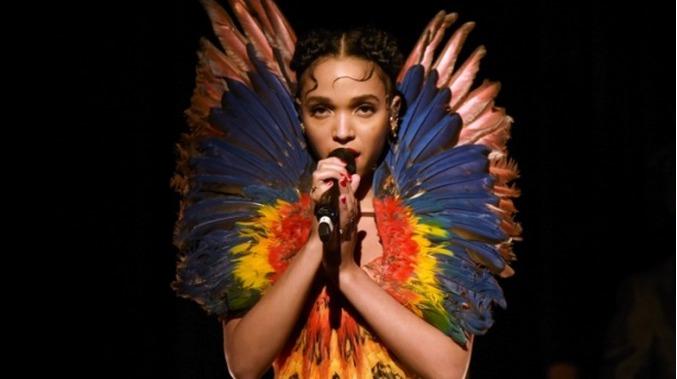First published in Daily Life, June 2015
Diversity isn’t about ticking boxes in the manner of a joyless bank clerk; it’s about recognising that there’s a life-affirming magic in being seen.
It’s not a stretch to hope that coming across FKA Twigs, powerful and resplendent, in a bird of paradise gown at the March 2015 launch of the London exhibition ‘Alexander McQueen: Savage Beauty’ could spark a queenly courage in a mixed-race girl dealing with high-school bullies. That an ad for moisturiser featuring Chinese supermodel Liu Wen might represent a tiny affront to the notion that Asian women are either exotic or invisible, and that Lupita Nyong’o’s journey from unknown to Oscar winner is a victory for those with dark skin and outsize ambition. Or that the existence of brilliant Lebanese-British human rights lawyer Amal Clooney is an antidote to a world ruled by Jennifers and Angelinas, even as her glossy-haired perfection is out of our league.
The American lexicographer Erin McKean tells us that “prettiness is not a rent you pay for occupying a space marked female”, but discounts the fact that beauty is often the truest barometer of our unequal world. When this barometer registers something beyond blonde hair and white skin, there’s a fighting chance of closing the gap.
In the last few years, the beauty ideals once embodied by all-American golden girls like Christie Brinkley and suntanned glamazons like Elle Macpherson have started changing form.
In 2014, Nairobi-born Nyong’o signed a lucrative deal to become the face of Lancome cosmetics and the Chinese supermodel Liu Wen, who rose to fame as fashion houses grudgingly acknowledged the growing Asian luxury market, earned $US 7 million, ranking fifth on Forbes list of richest models in the world. These days, non-white beauty isn’t token; it’s closer to something that approximates real power.
However, a world in which a skin-lightening cream called ‘Whitenicious’ is a legitimate product rather than something you’d read about in The Onion, and Twigs, who’s dating Robert Pattinson, regularly faces racist Tweeters seeking eternal communion with Edward Cullen guarantees that things aren’t ever this clear-cut.
In ‘The Inconsistent Acceptance of Black Beauty’, a May 2015 Huffington Post article, Lauren Dozier – a writer who’s had a lifetime of white girls use her skin colour as a door prize in an ill-fated Tanning Olympics – highlights the ways in which perceptions of racialised beauty are shaped by very specific markers and circumstances.
“Black beauty is only acceptable in certain contexts or in small doses. Keep the full lips; leave the coarse, high-maintenance hair. Cornrows are called ‘edgy’, ‘innovative’, and ‘epic’ when the braids sit above an alabaster face, but are ‘ratchet’ or ‘ghetto’ on a black girl. Only when bearing the seal of approval from high profile celebrities and style icons are these features deemed acceptable or beautiful,” she writes.
But as Buzzfeed‘s Anne Helen Petersen found out in her fascinating September 2014 Tinder experiment that aimed to replicate the dynamics of online attractiveness, our celebration of racialised beauty isn’t just down to white fashion editors or the style whims of Miley Cyrus – it’s about how we view race through the lens of factors such as class.
Petersen discovered that Yasmin, a mixed-race woman who was voted the most desirable, garnered an 89 per cent swipe-yes rate because her straight, white teeth and clear, caramel skin suggest a middle-class affluence that makes ethnicity fade into the background, while Lindsey, a 25-year old black woman, was universally rejected because bold makeup and cluttered clothing brought her difference into sharper focus.
As Rawiya Kameir points out in a May 2014 The Daily Beast article, Nyong’o might be stunning but we recognise her beauty at the expense of women like Precious star Gabourey Sidibe because her Ivy League pedigree and smooth, TransAtlantic accent speaks to class aspirations that are rooted in whiteness, one that flattens her Otherness and marks her out as “one of us.” Twigs, who taught herself to produce videos so she could engineer every aspect of her artistic persona, and Wen, who revealed the grit and determination that catapulted her to stardom in a September 2014 Vogue essay, fit neatly into the class fantasy that elevates those who are exceptional while ignoring the messy business of social change.
In her moving February 2014 speech at the ‘Black Women in Hollywood’ luncheon, Nyong’o reminded us of the importance of diversity and why rewriting old ideas of beauty means so much.
“I remember a time when I too felt unbeautiful. I put on the TV and only saw pale skin. I got teased and taunted about my night-shaded skin. And my one prayer to God, the miracle worker, was that I would wake up lighter-skinned… When I saw [supermodel Alek Wek], I inadvertently saw a reflection of myself that I could not deny. Now, I had a spring in my step because I felt more seen, more appreciated by the far-away gatekeepers of beauty,” she said.
The gatekeepers of beauty might be catching up with a world that’s no longer defined by Elle Macpherson or Christie Brinkley, but whiteness still needs a way to survive. By being selective about those it deems ‘beautiful’, it gets to control who benefits from life-affirming magic.
